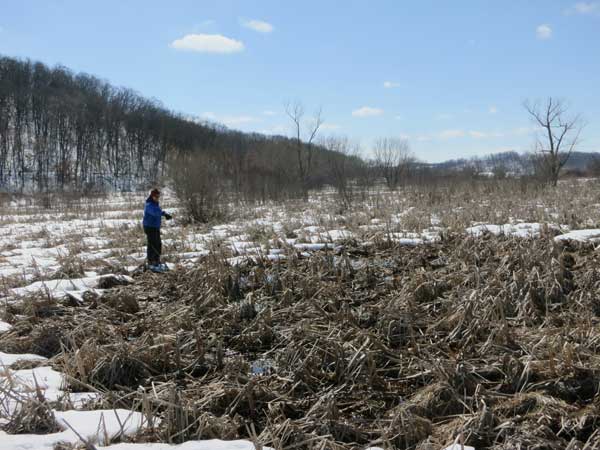Grape vine infestations
Grape vines are troublesome in some areas of the two State Natural Areas Kathie and I manage. They sprawl over everything and shade out the good plants. We spend quite a bit of time eradicating them.
On the south-facing slope at Pleasant Valley Conservancy grapes are especially prevalent in the areas we call the "road cut", as the photo below shows.
The road cut is actually a separate ecosystem from the rest of the south-facing slope. It is considerably steeper and hence gets much more intense sun (as the snow-melt patterns show). Hence it is much drier than the rest of the slope, making it difficult for the prairie grasses to compete.
The only way to eradicate grape vines is with herbicide, and because of visibility fall is the good time. Three, four, or more long stems generally grow from a single root system, so if you can find that center you can get rid of the whole plant at once. It is best to grab a single stem and follow it back to its base, where the other stems should be visible. Basal treat each stem with 20% Garlon 4 in oil. The photo shows Kathie working on the road cut seen in the top photo. The most time consuming part of the task is finding the center. A quicker way to find the center is to wait until late fall or winter when the root system is easier to deal with, although because the leaves are gone, you can't find the plant as easily.
Unfortunately, eradicating grape is a slow process, but well worth doing.
The photo below shows the same south slope three years later. It is essentially grape-free.
On the south-facing slope at Pleasant Valley Conservancy grapes are especially prevalent in the areas we call the "road cut", as the photo below shows.
 |
| Grape vine infestation on the road cut, fall 2008. Because of their color, grapes are easy to find in the fall. |
The only way to eradicate grape vines is with herbicide, and because of visibility fall is the good time. Three, four, or more long stems generally grow from a single root system, so if you can find that center you can get rid of the whole plant at once. It is best to grab a single stem and follow it back to its base, where the other stems should be visible. Basal treat each stem with 20% Garlon 4 in oil. The photo shows Kathie working on the road cut seen in the top photo. The most time consuming part of the task is finding the center. A quicker way to find the center is to wait until late fall or winter when the root system is easier to deal with, although because the leaves are gone, you can't find the plant as easily.
Unfortunately, eradicating grape is a slow process, but well worth doing.
The photo below shows the same south slope three years later. It is essentially grape-free.
 |
| Same road cut essentially grape-free, 2011, three years after eradication. |











